Mushrooms
Media
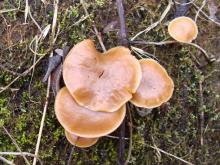
Species Types
Scientific Name
Galerina marginata (G. autumnalis)
Description
The deadly galerina has a brownish, sticky cap, yellowish to rusty gills, and a ring on the stalk. It grows scattered or clustered on deciduous and coniferous logs.
Media

Species Types
Scientific Name
Russula virescens
Description
Green cracking russula has a cap with a greenish, cracked, mosaic-like top, and cream-colored gills. It grows singly or in groups in mixed woods.
Media

Species Types
Scientific Name
Pluteus atricapillus (formerly P. cervinus)
Description
The fawn mushroom has a brownish gray cap with whitish to pinkish gills and a whitish stalk. It grows singly or scattered, on dead wood or on the ground over buried wood.
Media
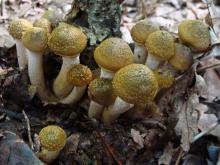
Species Types
Scientific Name
Armillaria mellea
Description
The honey mushroom has a honey-colored, sticky cap with black hairs over the center, and a stalk with a whitish ring. It grows in clusters at the bases of trees or stumps, especially oaks, and over buried wood.
Media

Species Types
Scientific Name
Gyromitra caroliniana
Description
The big red false morel belongs to a group of poisonous mushrooms. It has a reddish brown, convoluted, brainlike cap and a whitish stalk that is chambered inside. It grows singly or in groups in mixed woods.
Media
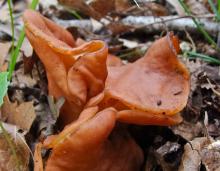
Species Types
Scientific Name
Gyromitra brunnea
Description
The gabled false morel has a reddish brown, lobed, wrinkled cap and a whitish stalk that is chambered inside, not hollow. It grows singly or in groups in mixed woods.
Media
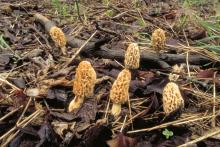
Species Types
Scientific Name
Morchella species
Description
Favorites among Missouri wild edibles, true morels only appear in the spring. They're very hard to see, but that's part of the fun of hunting them. Learn to identify them, and you can enjoy the hunt, too.
Media
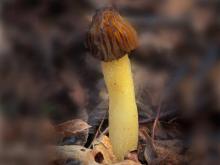
Species Types
Scientific Name
Morchella punctipes (formerly M. semilibera)
Description
The half-free morel is an excellent edible mushroom. It's completely hollow. It has a honeycombed cap with brownish black ridges and yellowish brown pits. The bottom half hangs free from the whitish stalk.
Media

Species Types
Scientific Name
Morchella esculentoides (formerly M. esculenta)
Description
The yellow morel is a choice edible mushroom. It has a honeycombed cap with yellow to grayish to tan ridges and pits. It is completely hollow and grows in the spring.
Media

Species Types
Scientific Name
Gymnosporangium juniperi-virginianae
Description
With their gelatinous orange tentacles, cedar-apple rust galls are one of Missouri’s freakiest sights in spring. Cedar-apple rust is a fungus with a two-part life cycle. Its two unrelated host plants are a juniper, such as eastern red cedar, and a tree in the rose family, especially apple and crabapple.
See Also



Media

Species Types
Scientific Name
Monotropa hypopitys
Description
Pinesap is a plant that puts the "wild" in wildflower! It lacks chlorophyll, so its roots connect to fungi underground and absorb nutrients from the fungi.
Media

Species Types
Scientific Name
Cladophora, Pithophora, and Spirogyra spp., and others
Description
Filamentous green algae forms green, cottony masses that are free-floating or attached to rocks, debris, or other plants.
Media

Species Types
Scientific Name
Monotropa uniflora
Description
Indian pipe lacks chlorophyll, so it is white, not green. Below ground, its roots join with fungi that connect to tree roots. This plant, then, takes nourishment indirectly from the trees.
About Mushrooms in Missouri
Mushrooms are a lot like plants, but they lack chlorophyll and have to take nutrients from other materials. Mushrooms are neither plants nor animals. They are in a different kingdom — the fungi. Fungi include the familiar mushroom-forming species, plus the yeasts, molds, smuts, and rusts.
Always be cautious when eating edible mushrooms. Be absolutely sure of the ID, and only eat a small amount the first time you try it to avoid a reaction..





















